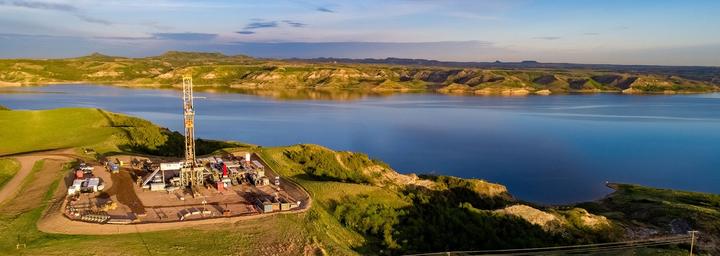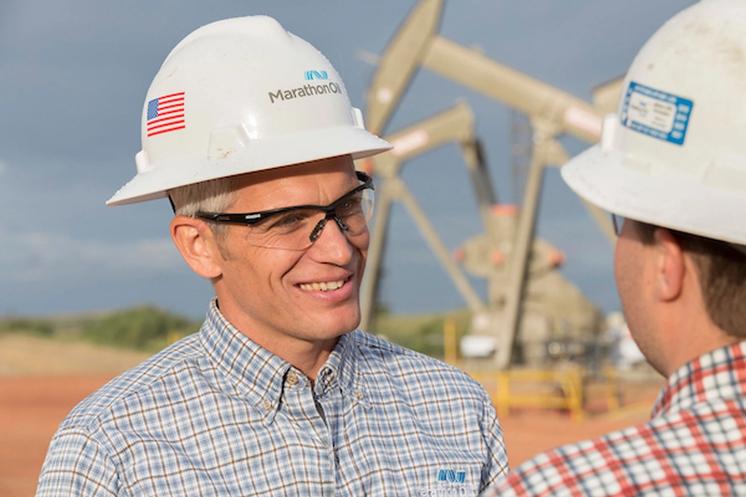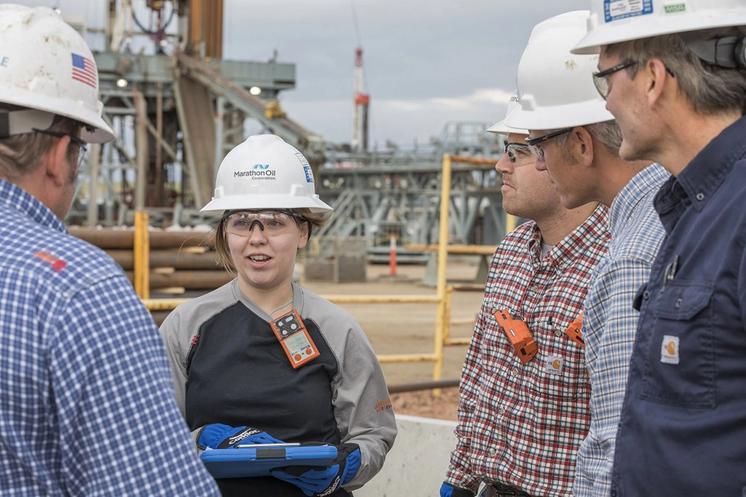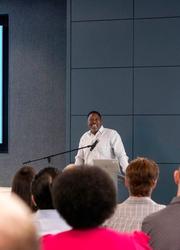
VP Mike Henderson Addresses Williston Basin Petroleum Conference
I’m pleased to be able to share a few thoughts on Marathon Oil and the bright future we see in the Bakken. This is a story of innovation, of transformation and of resurgence.
In less than decade, our country has moved from a position of energy scarcity to one of energy abundance. Driven by the innovation of independent E&P companies – and in collaboration with producing states – the U.S. resource plays have forever changed the energy landscape here at home and around the world.
Please note our forward-looking statements disclaimer.
The U.S. has achieved energy security. And I can tell you, Marathon Oil is proud to be here in North Dakota and part of this amazing U.S. energy renaissance.
We’ve undergone our own transformation as a company. When we separated from our downstream business in 2011, and became an independent upstream E&P, it came with a new strategic direction – a focus on U.S. unconventional resource plays.
As recently as 2013, only about two-thirds of our capital was allocated to the U.S. resources plays, with a large portion still directed to international, conventional exploration and oil sands mining. And the resource plays accounted for only about 30% of our production mix.
We saw the profitability and the growth potential here in the U.S. and started the heavy lifting to get our portfolio aligned with our resource play-focused strategy. We divested of non-core assets that didn’t compete for capital allocation, more than $4 billion worth in just the last two years. And we played offense with two Permian Basin acquisitions in 2017.
Our progress has been dramatic. We’ve pivoted our portfolio and differentiated ourselves as the only independent E&P with a material footprint in all four of the best oil rich resource plays in the United States -- the Bakken, the Eagle Ford, STACK/SCOOP, and the Permian.
We now allocate over 90% of our capital to these plays; and they account for about 70% of our production mix today, driving a natural expansion in margins and increasing cash flow.
The Bakken, in particular, features prominently in our future outlook. This evolving basin is one of the best unconventional oil reservoirs in the U.S. and it competes at the very top of our multi-basin portfolio.
It was only natural for us to find ourselves as one of the leaders of the recent Bakken resurgence.
Yes, resurgence. The Bakken has been through it’s own ups and downs. But the Bakken is back, and technology has played a significant role. Let me step you through a few of our most recent milestones and show you why Bakken is becoming a benchmark for the high-tech shale oilfield of the future.
For those who know our history, you may recall that Marathon Oil entered the Bakken with a 2006 acquisition, which at the time, represented our Company's first significant foray into the shale plays. Since then, we’ve produced more than 100 million barrels of oil in the Bakken. We know this region well, and appreciate the history, the people and communities that make this area special.
The early lessons we learned operating in the Bakken have allowed us to better understand shale and deepen our expertise. It's remarkable to look back and see what we’ve achieved.
One of the most important lessons we’ve taken from the Bakken, is to never be satisfied with the status quo.

Not too long ago, in 2015 and 2016, the atmosphere could have been considered rather bleak. Like many operators, we decreased drilling activity in the commodity downturn and allocated our limited capital to the highest returns in our portfolio, and were nearly inactive in the Bakken.
We navigated a very challenging macro environment by staying focused on the elements of the business within our control – disciplined capital allocation, reducing costs, capturing efficiencies and portfolio management.
We went down to one rig in 2015 and released it in early 2016… but that’s when the story gets interesting. As we down-shifted on drilling, our teams focused on improving our technical workflows and enhanced completion designs to maximize well productivity.
They got to work cracking the code, so to speak, and pushed the physics limits. We saw wells consistently outperforming historical type curves. And strong well productivity and high reliability continued to support our base production.
Then, in 2Q 2016 we began bringing on record-setting wells in Myrmidon, which is an area that crosses McKenzie and Mountrail counties. And remember, we didn’t have any drilling rigs working at that point in time. When we completed the Clarks Creek Middle Bakken well, its 30-day IP rate was at that time the highest rate well in the Williston basin for the past three years.

In the second half of 2016, the Maggie pad in East Myrmidon outperformed expectations with basin-leading 90-day production rates.
Meanwhile, our Bakken costs had decreased significantly. Despite our higher intensity completions, completed well costs were averaging $6 million per well. And the completion of a large-scale water gathering system enabled us to move much more of our produced water via pipeline, which lowered our water handling costs… and got more trucks off the roads.
As commodity prices began to stabilize, we resumed drilling with one rig in fourth quarter 2016. And with confidence in our results, we surprised the market by stating we would average six rigs in 2017.
The stellar results we achieved in Myrmidon encouraged our team to revisit the potential in the Hector. This is an area in Dunn county, where we have 115,000 acres, about twice the size of Myrmidon, but the area has fewer natural fractures and historically, had less prolific wells.
In the second quarter of last year, 2017, we started to apply our learnings, and brought on our first two Hector wells with enhanced completion designs. Right away, we saw those wells performing above expectations.
In 3Q 2017, our Clarice Middle Bakken well in Hector set an industry record for the best 30-day oil rate in the Williston Basin. And since then, in first quarter of this year, our Arkin well, also in the Hector area but a Three Forks well, beat it with another new record oil rate. Hector wells are generating well performance that’s uplifting our economics and inventory quality, essentially expanding what we would call our core position.
We’ve also continued our basin-leading performance in Myrmidon with the record-setting Forsman Middle Bakken well in 4Q, which was then beat out by our own June and Chauncey wells in the first quarter.
I had the opportunity to be out in the field yesterday visiting with our amazing employees, and I commend each one for what they’ve accomplished.
What I saw was not only execution excellence, but a team committed to being safe and responsible, while having fun at their jobs too. And that’s fantastic.
You might be wondering what’s the secret sauce? What drove our step-change in Bakken performance, in the midst of the downturn.
I can tell you… It’s two parts talent and one part technology. Our people are the first ingredient. Here in the Bakken, our team wasn’t satisfied. They wanted to improve the asset’s performance and to be “best in basin.” So they started trying new things.
That’s where technology comes in. In the case of Hector, they re-evaluated the geologic parameters using tools that weren’t available when the area was first assessed a decade ago.
Using more advanced 3-D modelling, the team simulated results that could be achieved under different completion techniques. Subsurface, completions, drilling – all these teams came together to discover, integrate, collaborate and apply new ideas.
At the same time, on the production end, new artificial lift approaches including submersible pumps and jet pumps contributed to higher base production rates. Our production engineering supervisor called artificial lift ‘the icing on the cake’ and reflects our philosophy of optimizing the full life of the well.
Everyone on the Bakken team pulled together to achieve what we accomplished in 2017. That’s the power of people and technology coming together.
But I said “two parts people.” What I mean by that, is it’s talent and culture.
Without a culture that allows and encourages people to be bold, take ownership and take calculated risks, you’ll never discover the full potential of the technology and the tools that you have at your disposal. The Bakken team pushed the limits and did not hesitate to explore the art of the possible.
That’s the secret sauce. People who want to push things forward, technology that enables better performance, and a culture that allows innovation to happen.
At Marathon Oil, we look at technology and innovation as necessary elements for how we’ll compete to be the premier E&P. Being able to think differently … and act differently … is what we believe will drive our performance.
We’re a results driven company, and how we achieve those results is equally important to us. Our employees place safety and integrity first in all we do—they are bold, they take ownership and we are one team.
What’s vitally important for our industry today is leveraging technology to make our business more efficient … to find more oil and gas … and to produce it safely and at a low cost.
We must take advantage of the linkage between innovation and operational excellence. The two are intertwined. I’m talking about the drive to find creative solutions that can really make a step change in our business. To ask and answer those questions that look forward.
It’s also a shift in how we think about innovation in the digital space in concert with our traditional subsurface focus.

Our innovation has been heavily focused on the subsurface, where it should be. The subsurface is what makes our industry so unique AND so challenging. And the industry has greatly improved our capabilities around seismic; 2D, 3D, 4D, micro. New ways for geologists to interpret what’s going on below the surface. As well as new and higher intensity completions techniques.
That’s all very necessary. But we also need to leverage the large data sets we all have in our companies to solve new -- or old -- problems.
It’s common and comfortable to use data for historical purposes, asking: What was our production? What were our economics for this well? That is all backward looking . . .
But, we should also be using that data for making reliable predictions.
Asking: Where’s the best place to drill? How far apart should these wells be? What’s the right landing zone? What will be the ultimate recovery for the well?
We can start answering these questions with more precision and accuracy with the data we have today, by looking at data differently.
Other industries have already seen the value in this approach—aerospace, medicine, retail—they are well ahead of the the oil and gas industry but we are closing the gap.
We do not suffer from a lack of data. It’s a question of how can we take all this data that we’ve accumulated and learn from it? Not just react to it … but, be able to do something differently with it in the future.
Think about the on-line tech companies, like Google … Amazon … Netflix. These companies employ digital technologies and machine learning to predict consumer behaviors, and see emerging trends in near real time.
Think about how much enterprise value these companies have generated based on how they leverage data.
Why can’t the oil and gas industry leverage our data in the same way? We can, and we should.
Some companies are already starting to figure this out … and we’re starting to leverage it more and more at Marathon Oil. It’s the idea that we can use this data – coupled with our understanding of the science and the physics – and be much more accurate and efficient in finding and producing oil and gas. Especially in unconventional resource plays.
Data driven decision making and predictive capabilities will be essential across the life cycle of our unconventional assets--from delineation and appraisal through to full field development.
- Already, field operations are being monitored in real time, with a frequency and accuracy unimaginable even a few years ago. Machines are learning to automatically manage individual wells and entire facilities,
- Algorithms are being developed to predict events creating actionable alerts,
- User-based views or dashboards will support multiple work processes. That’s the digital oil field.
Now, everybody in the industry is talking about big data, data analytics and machine learning. A lot of that talk is … well, just talk.
If we’re going to innovate like a tech company, it’s going to take more than some trendy IT buzzwords and a Silicon Valley-style office environment to make it happen.
At Marathon Oil, we’ve made a very deliberate and conscious effort to consider exactly what technology we apply, and what we apply it to. And if it doesn’t have a grounding in the business … if it doesn’t support finding oil and gas, and producing it cheaply and safely … it doesn’t have a high spot on our priority list.
For instance, using a data aggregator tool, our drilling team is monitoring trends and able to identify not only what has and has not worked in the past, but analyze the “why” and make further improvements. As a result, they’re optimizing everything from operating parameters to crew efficiencies.
We’re bringing in more people who can marry data and mathematics with geoscience and reservoir engineering. People who can integrate data and develop models that see trends or anomalies that simply wouldn’t have been seen with traditional interpretation methods.
That’s the future of the industry. The popular paradigm that oil and gas is low tech, well, that’s being rapidly displaced by a new vision, the digital oil field. And we’re applying the digital oil field right here in the Bakken.
Our control center is another example. Using dashboards to visualize data enables an operator to quickly interpret masses of information. Because real-time data is only as good as your ability to act on it.
Other tools we’re using or evaluating include machine learning to optimize production and Augmented Reality tools used in operations and facility maintenance.
We want to leverage all four of our US basins to generate and share learnings and innovations in real time—an advantage of our multi-basin model that spans the development cycle from early appraisal to full development pad drilling, different geologies, different fluid types and different operating challenges.
These are all exciting innovations but none of this possible, if we lose focus on our license to operate—a license that we earn each and every day.
When concerns arise, we must address these topics in the right way, and with a sense of urgency. We must put them into context, engage openly and honestly with those who are voicing concerns, demonstrate our ongoing commitment to safe and responsible operations and be solution driven.
At Marathon Oil, responsible operations tie directly to what we call “Living our Values.”
It means that we are ever mindful of the communities in which we operate … of the people who allow us into their cities and towns, who work in our fields and who share in our success.
We must be responsible corporate neighbors and never lose sight of the fact that we’re guests in these communities — and that we’ll be judged by our individual and collective behaviors.
This goes hand-in-hand with our commitment to safety and environmental protection, and is essential if we are to protect our license to operate. Compliance with regulations and laws is not negotiable.
As we continue to bring on these basin-leading wells that I mentioned earlier, we are proactively managing gas capture to remain in full compliance with all of North Dakota requirements and have the necessary flexibility to ensure no flow assurance or regulatory issues as we continue to pursue this high-return program.
We’re bullish on the Bakken. And optimistic about how our industry and Marathon Oil will continue to develop technologies to boost profitability and improve sustainability.
It all comes down to the ingenuity and drive that people in our industry bring to the table every day, finding solutions to real life challenges. We’re constantly evolving and improving. We continue to optimize completion designs to improve well productivity, increase capital efficiency and reduce costs while generating returns for our shareholders.
I want to thank our Bakken team members who’ve contributed to the success and resilience of this important asset. There’s a lot to be proud of. We wouldn't be here today without their hard work, drive, commitment and ingenuity.
I look forward to many more good years ahead as we further develop this competitive and high-quality resource in North Dakota.























